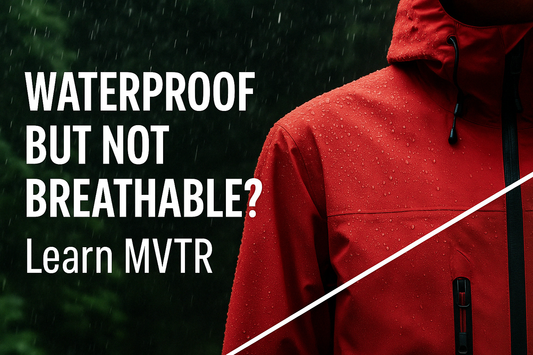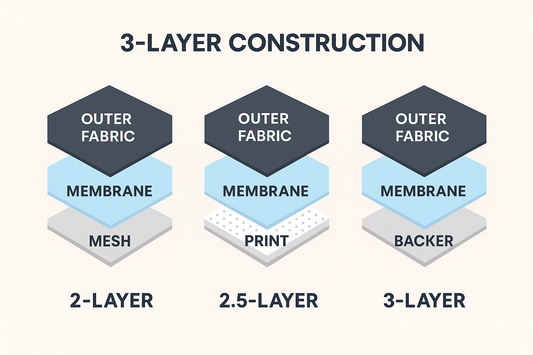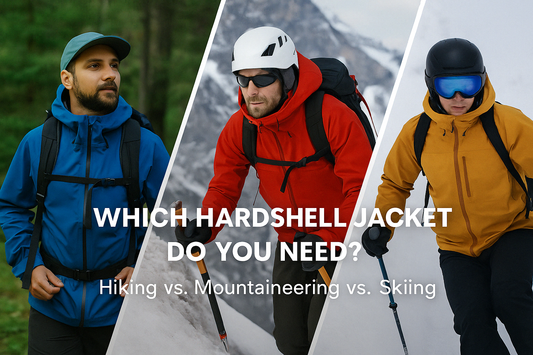
Shell vs Insulated Jacket: The Difference and How to Choose for Skiing
Share
If you’ve ever hesitated between grabbing a light shell or a warm puffer, you’re not alone. The difference isn’t just about style — it’s about how each jacket handles weather, warmth, and movement.
In this guide, we’ll break down what each type actually does, when to wear it, and how to choose the best one for skiing, travel, or daily winter use. Along the way, we’ll look at how Alpargali’s technical designs — from advanced shell layers to aerogel-insulated puffers — bring performance and comfort together for real-world wear.
What Is a Shell Jacket and Why Is It Called a “Shell”?
A shell jacket is called a “shell” because it acts as your outer protective layer — the barrier between you and the elements. It’s designed to block wind, rain, and snow, not to provide warmth on its own.
The goal is simple: keep you dry and shielded from bad weather while letting heat and moisture escape from inside. In other words, a shell keeps the weather out and your comfort in.
There are two main kinds of shell jackets: hard shells and soft shells.
-
Hard shells are fully waterproof and windproof, built for harsh conditions. They’re the ones you wear when the forecast looks miserable — heavy rain, snow, or strong wind.
-
Soft shells are more flexible and breathable. They repel light rain and block wind but prioritize comfort and movement. They’re great for dry, cool days or for active use when you’re generating body heat.
Most quality shells use either a two-layer (2L) or three-layer (3L) construction. A 2L shell bonds a waterproof membrane to the outer fabric and adds a loose liner for comfort; a 3L shell laminates all layers together, making it lighter, more durable, and better at breathing during high activity.
What Is the Purpose of a Hard Shell Jacket?
A hard shell jacket is for wet, cold, or windy conditions — when staying dry matters most. It’s ideal for skiing, mountaineering, or stormy commutes where full waterproof protection is essential. In short, it’s made for harsh, unpredictable weather when you can’t risk getting soaked or chilled.
What Is the Purpose of a Soft Shell Jacket?
A soft shell jacket is for active use in cool, dry, or mildly windy weather. It’s perfect for hiking, cycling, spring skiing, or everyday wear when you want flexibility and breathability over full waterproofing. A soft shell jacket also works perfectly as a transitional layer — worn on its own in mild weather or under a hard shell when conditions turn rough. The Alpargali Coreshell Jacket is a good example, offering balanced protection and comfort for early winter, late autumn, and cold spring transitions.
What Are the Benefits of a Soft Shell Jacket?
Soft shell jackets are popular because they feel comfortable and versatile while still offering performance. Their benefits include:
-
Breathability: They let heat and moisture escape, keeping you dry from the inside.
-
Flexibility: The stretch fabric moves easily with your body.
-
Comfort: Softer, quieter materials make them pleasant for daily wear.
- Light weather protection: They handle wind and light rain without feeling bulky.
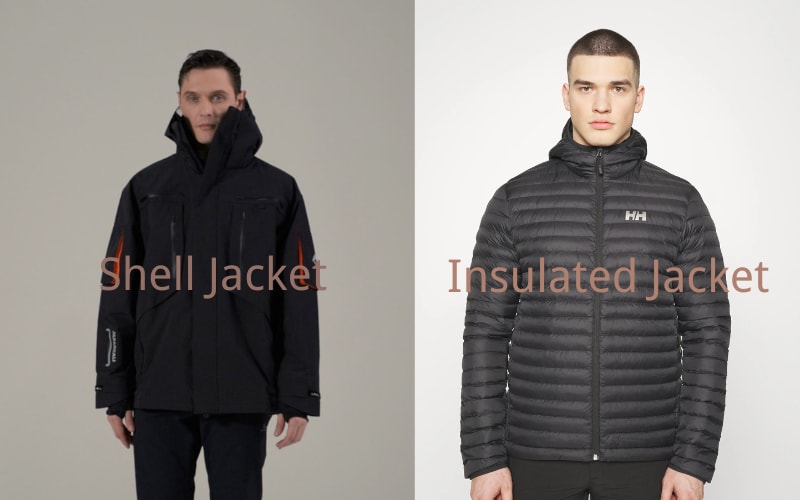
What Is an Insulated Jacket?
An insulated jacket is, quite simply, a jacket built to keep you warm when the temperature drops. It has two main parts: a durable outer fabric that blocks wind or light moisture, and an inner layer of insulation — usually synthetic fill or natural down — that traps body heat.
Unlike a simple shell jacket that only blocks wind and rain, an insulated jacket provides both warmth and weather resistance in a single piece, making it ideal for winter or low-activity use.
The biggest reason people choose insulated jackets is ease. You don’t have to think much about layering — just throw it on and you’re set for a cold day. They work best in steady winter conditions or on days when you’re not moving a lot, like waiting for a lift at the ski resort, walking through a frozen city, or heading out for a quiet hike in the snow.
There are two main types of insulation:
-
Down insulation — lightweight, compressible, and incredibly warm, perfect for dry, frigid climates. Its only drawback is that it loses insulation power when wet.
- Synthetic insulation — slightly heavier but more versatile. It retains heat even when damp, dries quickly, and performs better in mixed or humid weather.
At Alpargali, we take insulation a step further with graphene and aerogel fabrics, which help our jackets stay surprisingly light yet reliably warm — built for comfort in motion, not bulk.
Learn more about how these technical fabric jackets compare to Down and Synthetic jackets.
What Is the Difference between an Insulated Jacket and a Shell Jacket?
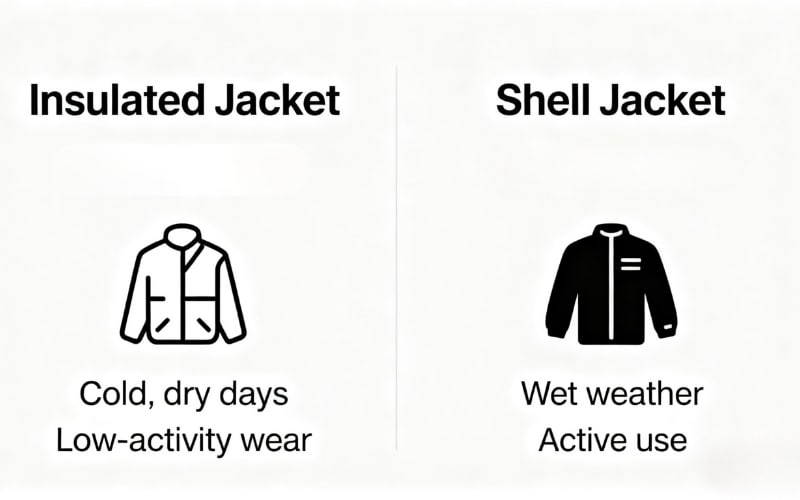
The difference between an insulated jacket and a shell jacket comes down to how each one manages warmth, protection, and flexibility. They may look similar on the rack, but they perform very differently once you’re out in the cold.
1. Warmth and Insulation
An insulated jacket has warmth built in. It uses down or synthetic fill to trap heat inside the jacket, so you don’t have to wear much underneath. That makes it perfect for cold, consistent weather — think mid-winter city commutes, resort skiing, or travel in freezing temperatures.
A shell jacket, by contrast, has no insulation at all. It’s meant to block wind, rain, and snow, not to generate heat. To stay warm, you layer underneath it — a base layer and a mid-layer — which gives you more control as temperatures change throughout the day.
2. Breathability and Moisture Management
Because a shell jacket doesn’t have insulation, it’s naturally more breathable. Moisture and body heat can escape more easily, which matters when you’re hiking uphill, skiing hard, or wearing a backpack.
Insulated jackets can feel warmer but less breathable. The insulation traps heat effectively, but it can also trap sweat if you’re active. They’re better suited to lower-output days — not long climbs or fast descents.
3. Weather Protection
Both styles can be weather-resistant, but they do it differently.
-
Shell jackets use waterproof membranes (like Gore-Tex or similar) and sealed seams to provide maximum wind and rain protection.
-
Insulated jackets vary — some are just water-resistant, while others (often called insulated shell jackets) combine a waterproof outer shell with internal insulation for both protection and warmth.
If you often face wet, stormy conditions, a shell is the more reliable choice.
4. Weight and Packability
In general, shell jackets are lighter and easier to pack. You can roll one up and stash it in your bag without taking much space.
Insulated jackets are bulkier — especially those filled with synthetic insulation — though modern materials have made them lighter than they used to be.
5. Versatility
This is where the shell shines. Because it’s just an outer layer, you can wear it year-round by changing what’s underneath. Add a fleece or puffer in winter, and you’ve got warmth; wear it over a T-shirt in spring, and it becomes a rain jacket.
Insulated jackets are simpler but more season-specific. Once the temperature climbs, they often feel too hot to wear.
6. Best Use Scenarios
|
Situation |
Best Choice |
Why |
|
Cold, dry days |
Insulated jacket | Built-in warmth, minimal layering |
|
Wet or changing weather |
Shell jacket | Waterproof and adaptable |
|
Active use (hiking, skiing, climbing) |
Shell jacket | Better breathability |
|
Low-activity or daily winter wear |
Insulated jacket | Warm and easy |
|
Travel or mixed climates |
Shell jacket | Packs light, works year-round |
7. Price and Longevity
High-quality shells can cost more up front, especially those using premium waterproof membranes, but they also last longer — there’s no insulation to compress or wear down. Insulated jackets are generally more affordable but may lose loft (and warmth) over time.
In Short
-
Insulated jacket: Simple, warm, ready for the cold.
-
Shell jacket: Adaptable, breathable, built for change.
At Alpargali, we design both types with technical fabrics that emphasize lightness, breathability, and longevity — so whether you prefer a minimalist shell jacket or a warm insulated jacket, you get performance that feels effortless and lasts beyond one season.
Shell vs Insulated Jacket for Skiing
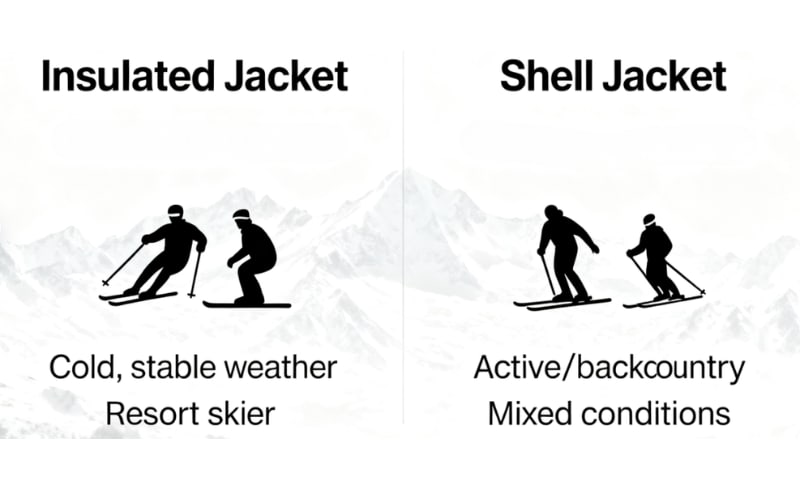
When it comes to skiing, choosing between a shell and an insulated jacket depends less on fashion and more on how you ski, where you ski, and how much heat you generate. Both can work beautifully — but they’re built for very different kinds of days on the mountain.
Shell Jackets for Skiing
A shell ski jacket is the go-to for skiers who value adaptability and performance. It’s fully waterproof and windproof but has no built-in insulation, so you control your warmth through layering. That flexibility is a big deal on the mountain, where weather and activity levels change constantly.
For example, you might start the day in subzero temperatures, hike to a ridge, and end in spring sun at the base. With a shell, you can simply add or remove layers — base, fleece, or mid-puffer — without ever feeling trapped in too much heat.
Shells also tend to be lighter and more breathable, which helps if you’re skiing off-piste, skinning uphill, or just someone who runs hot. High-end shells, like those using 3-layer waterproof membranes, are designed for serious weather and serious movement.
In short, shell jackets are the best choice for active skiers, variable climates, and long seasons. You’ll see them everywhere in the backcountry or on resort riders who ski from November to April and need gear that can handle it all.
Insulated Jackets for Skiing
An insulated ski jacket simplifies things. It has warmth built in, so you don’t need to fuss with multiple layers. Just zip it up and you’re good to go — ideal for resort days, chairlift rides, and colder regions where the temperature stays low all winter.
Most use synthetic insulation, which performs well even if a bit of snow or moisture gets through. Down-filled versions are warmer but better for dry, cold conditions. The trade-off is that insulated jackets are less breathable and less adaptable — once you heat up, you can’t really “cool down” without taking it off.
They’re perfect for low-exertion skiing — think long lift rides, relaxed downhill runs, or anyone who tends to run cold. And because they combine warmth and protection, they’re easy to grab for other winter activities too, from après-ski evenings to commutes in the snow.
Do I want a shell or an insulated jacket when skiing?
|
You Are… |
Best Choice |
Why |
| An active skier or backcountry rider |
Shell Jacket |
Lets you manage temperature and layers easily |
| Skiing in cold, stable weather |
Insulated Jacket |
Built-in warmth, no layering needed |
| Often skiing in mixed or mild conditions |
Shell Jacket |
More breathable, less chance of overheating |
| Resort skier who values comfort |
Insulated Jacket |
Cozy and simple for long lift rides |
| Traveling or skiing across seasons |
Shell Jacket |
One jacket that works year-round |
Is a Soft Shell Jacket Warm Enough to Ski In?
Yes — but only in mild or dry conditions. A soft shell keeps out wind and light snow, making it fine for spring skiing or high-intensity runs. But in cold or wet weather, it’s not warm enough on its own — you’ll need extra insulation or a waterproof hard shell layered over it.
Best Shell Jacket for Skiing — What to Look For
The best shell ski jackets all share a few essentials. A great shell should do three things:
-
Keep you dry and protected with solid waterproofing (around 15K–20K).
-
Regulate temperature through good breathability and venting, so you don’t overheat.
-
Give you freedom to move and layer comfortably, without feeling bulky or stiff.
Add in smart touches — things like easy-access pockets, adjustable cuffs and hoods, and durable zippers — and you’ve got a jacket that feels as reliable in the city as it does in the snow.
The Alpargali All-Weather Outdoor Jacket checks all those boxes — and then some.
With 15K waterproofing and 15K breathability, it stays dry in snow or rain yet lets heat escape during active use. The underarm vents give you instant temperature control, while the high neck, adjustable hood, and storm flap keep out wind on chairlifts or mountain ridges.
But what really makes it stand out is how it fits into everyday life:
-
14 waterproof pockets mean your phone, wallet, and ski pass all have a safe place — no digging or juggling.
- It’s light and unrestrictive, so it works for skiing, commuting, or travel.
- The reflective details add safety for night rides or late walks home.
If you’ve ever wished one jacket could replace the pile in your closet — something that works in the city and on the slopes — this is it.
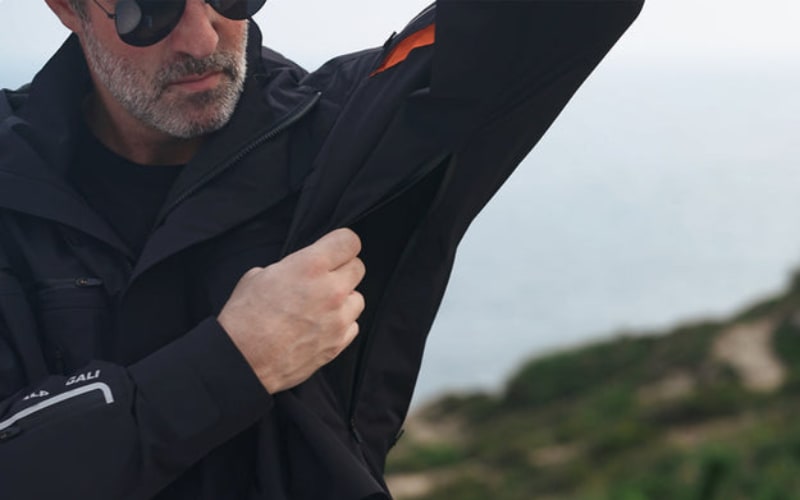
What Type of Jacket Keeps You the Warmest?
If your top priority is staying warm in freezing conditions, look for a jacket that traps heat efficiently while blocking wind and moisture — without becoming heavy or stiff.
The warmest jackets share a few key traits:
-
Efficient insulation that traps body heat (down, synthetic, or next-gen materials like aerogel or graphene).
-
Windproof and water-resistant outer shell to stop cold air from cutting through.
-
Breathability, so you stay dry inside even when you move.
-
Smart fit and construction, sealing warmth around cuffs, collar, and hem.
In short: a great insulated jacket should keep warmth in, keep weather out, and still let your body breathe.
What Is the Warmest Type of Insulated Jacket?
The Alpargali Aerogel Graphene Puffer Jacket is one of the warmest insulated jackets ever made — not because it’s thicker, but because it’s smarter.
Instead of relying on bulky down, it uses aerogel, the same ultra-light material NASA uses to shield spacecraft from extreme cold. Just 1.0mm of aerogel creates a barrier so effective that warmth stays in and the cold never gets through. Inside, graphene fibers spread your body heat evenly, while Sorona® insulation adds softness and breathability.
Wrapped in a Teflon™ weather-resistant shell, it’s ready for anything — from a -40°C snowfield to a windy city street. What you notice most isn’t the technology, though. It’s how effortless the warmth feels: light on your shoulders, never stifling, always reliable.
It’s the kind of jacket that makes winter feel easy — not something to endure, but something to enjoy.
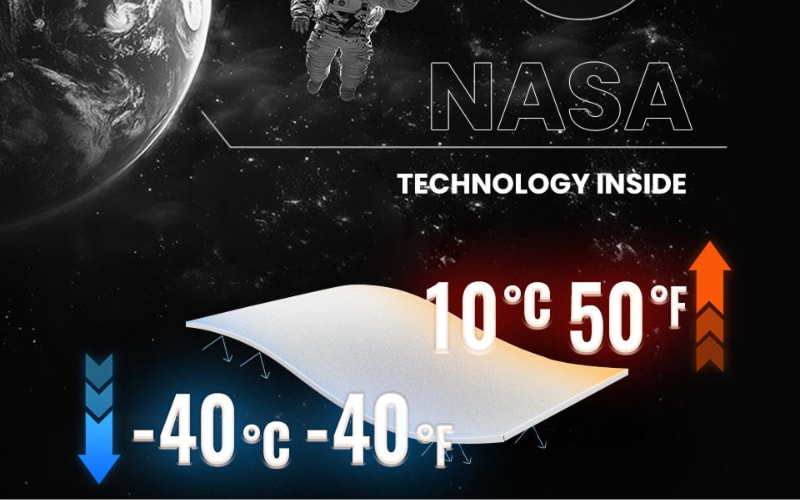
Do Shell Jackets Keep You Warm?
Not by themselves. Shell jackets are designed to block wind, rain, and snow, not to provide insulation. They keep warmth in only when paired with proper base and mid-layers underneath. Think of a shell as your outer shield, not your heat source.
What Temperature Is a Soft Shell Jacket Suitable For?
A soft shell jacket is ideal for cool to mildly cold conditions, roughly between 5°C to 15°C (40°F to 60°F) — depending on your activity level. It’s best for dry days, light wind, or active use like hiking or spring skiing. For freezing temperatures, you’ll need to add an insulating layer underneath.
The right jacket isn’t about surviving winter — it’s about enjoying it. The best jacket depends on how you move, where you live, and how much control you want over your comfort.
At Alpargali, our design philosophy sits right at this intersection — using advanced materials like aerogel and graphene to balance warmth, breathability, and weather protection for the modern man’s active, adaptive life.
If you’re still weighing your options, our Clothing Comparison Guide breaks it all down side by side — helping you see how each piece performs in real conditions, so you can choose with confidence.
